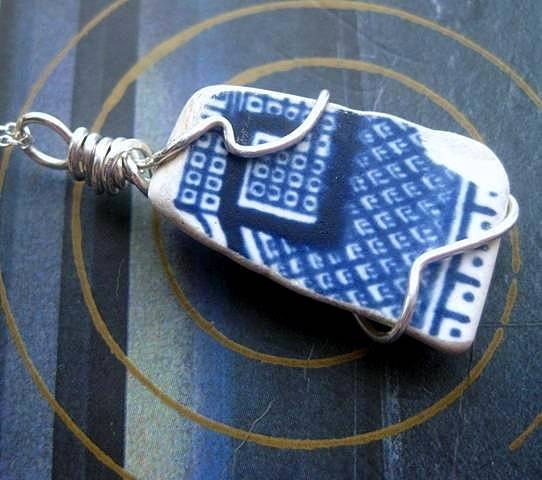Sea pottery is broken pottery, porcelain, tile and stoneware shards that have been tumbling and smoothing naturally in the sea for decades before washing up on the shore. It is also known as beach pottery, sea porcelain or sea china. It is very collectible and good quality specimens are popular for jewellery making. Smaller pieces look wonderful in mosaics and other artistic projects.
This naturally recycled material
can start out as table and kitchen ware, ornamental porcelain,
terracotta or ceramic tile, building materials etc. Often it was thrown
away as rubbish or somehow just ended up in the water.
The acidity and tumbling action of the ocean smooths the edges, deglazes and leeches elements from the porcelain giving it a 'chalkier' texture. This happens very slowly over decades.
Often, the top layer of colour or pattern can have been buffed away by silt and sand. Some pieces will have patterns of leaves, flowers etc and are enjoyed simply for their aesthetics.
Even if, like me, you only start out looking for beautiful pieces to use, it can be hard not to get excited by a shard that holds a clue to its origins.
 |
| Storm in a Teacup pendant |
Though it may have been manufactured abroad, as with sea glass, the source of the shard is usually local - ie it most likely fell into or was thrown into the sea on the same stretch of coast where it is found, or not a million miles away.
Much of the sea pottery found in Ireland and the UK dates back to the 19th and even 18th centuries. Of course, let's not forget that a piece that was made 200 years ago, might not have gotten into the sea until much, much later. It does however, take time to leech and exfoliate sea pottery to a very smooth condition. A well worn piece that landed in the sea say 50 years ago, could logically be a lot younger than a less weathered, but vintage, piece of pottery that has only been surfing for a few decades. In other words, the extent of evident weathering can give us an idea of how long a piece has been tumbling in rough seas, not how old it actually is. There are ways that experts can date a piece by looking at materials, shapes, firing methods etc. However, it's nowhere near an exact science when it comes to sea pottery.


Specimens may have recognisable patterns, such as the famous, Willow pattern, for example, adding to their appeal. The pendant on the left (now sold) is from the edge of a Willow pattern piece and the shard on the right shows well known elements from the design.
If you are lucky you may find a piece that has a real clue as to its origins. To start with, this piece clearly comes from England. Clementson Brothers turned out to be easy to trace online. The company was in operation in Hanly from c1865-1916. This sea pottery shard deserves a blog post all of its own!

One thing is sure, if you start collecting sea pottery and or sea glass for whatever reason, I guarantee you'll never be able to go to a beach again without peering down. I best warn you of the possible side effects: crick in the neck, sore back, aching joints, filthy hands, tired eyes, holes in your pockets oh, and watch out for euphoria when you find something truly amazing. That will be your complete undoing!
Useful links I came across:
Previous posts of similar interest:
The Willow Pattern
How to Clean Seaglass and Beach Pottery
Inspirations from Terracotta






Beautiful finds & crafty results, Anne-Marie! And yes, I agree with the last ;)
ReplyDeleteHey Heli, looking forward to beach combing with you and Mo in February!
DeleteWOW I had never heard or thought about sea pottery!! Thank you for this interesting post.
ReplyDeleteThis is a great post! Well written, informative and entertaining! I just joined the sea pottery Facebook page and look forward to being a part of the group!
ReplyDeleteI sell sea pottery and sea glass jewelry as Sea Glass Visions. You can find me on etsy and Facebook